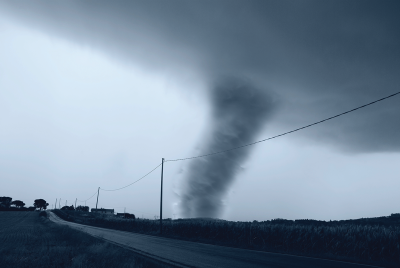METRO DETROIT — Although severe thunderstorms are a common occurrence in Michigan, many homeowners aren’t prepared.
Extreme weather can hit at any time — bringing heavy rain, flooding, lightning, damaging winds, large hail and even tornadoes. On average, Michigan has 15 tornadoes per year, according to state officials, who said the average lead time for a tornado warning is 10 to 15 minutes.
In the past 10 months, Michigan has had tornado outbreaks twice. The National Weather Service confirmed seven tornadoes touched down in Michigan on Aug. 24, 2023 — the most tornadoes in a single day during the month of August. One tornado touched down in Ingham and Livingston counties, three hit Wayne County, two touched down in Monroe County and another hit in Kent County.
Most recently, four tornadoes touched down in Kalamazoo, St. Joseph, Cass and Branch counties on the night of May 7, according to the National Weather Service, prompting Michigan Gov. Gretchen Whitmer to declare a state of emergency in those areas.
“In the last 10 months, we’ve had very real lessons that tornadoes can and do happen here in Michigan, and they can happen at different times of the year … so having a plan and being prepared is definitely key,” said Lauren Thompson Phillips, public information officer for Michigan State Police Emergency Management and Homeland Security.
One of the main things people should be aware of is the difference between a watch and a warning for severe weather.
“If you are hearing there’s a watch, that means conditions are right for severe weather. But if you’re hearing there’s a warning, that means that severe weather is coming, or a tornado has been spotted, so you better take cover,” Phillips said.
Whenever the thunder roars, it’s important to get indoors — whether that be a building, or, if none are nearby, a car — and remember to close all doors, windows and blinds.
If you’re outside with no place to shelter, experts say to seek low ground away from trees and metal objects.
In the event of a tornado, get to a basement or storm cellar. If there’s no basement, head to a small, interior room on the lowest level, making sure to stay away from windows, doors and outside walls.
Wherever you plan to take cover, you should store a home emergency kit — a collection of basic items that your household may need in the event of an emergency.
During and after severe weather, you and your family might need to survive on your own for several days, so having a three-day supply of food, water and other items is a necessity.
A basic emergency supply kit should include: a 72-hour supply of water, which is at least 1 gallon of water per person per day for drinking and sanitation needs; at least a three-day supply of nonperishable food per person; a manual can opener to open canned goods; a first aid kit; moist towelettes, garbage bags and plastic ties for personal sanitation; and household chlorine bleach and a medicine dropper to disinfect water.
The kit should also contain some basic tools and equipment including: a multi-tool, wrench or pliers to turn off utilities; a battery-powered or hand-cranked radio or a NOAA Weather Radio with tone alert; extra batteries; a flashlight; local maps; paper and pencils; a whistle to signal for help; matches in a waterproof container; a fire extinguisher; a dust mask to help filter contaminated air; and plastic sheeting and duct tape to shelter in place.
Because every household is different, additional items can be added to your kit based on your individual needs, including: prescription medications; glasses and contact lens solution; infant formula, bottles, diapers, wipes and diaper rash cream; pet food and water; feminine supplies and personal hygiene items; a complete change of clothing appropriate for your climate; sturdy shoes; and maybe even some activities for children.
Cash or traveler’s checks and important family documents — such as copies of insurance policies, identification and bank account records saved electronically or in a waterproof, portable container — are other suggested items to have on hand.
“You just want to be prepared in case you lose power, have any damage to your house or anything like that. It’s always good to be prepared and have a kit ready just in case,” said Lindsay Schwan, a planner with Oakland County Emergency Management.
Once you’ve assembled your kit, your family should decide where to store it, so everyone knows where it is in the event of an emergency — ideally, wherever you plan to take cover. Canned food should be stored in a cool, dry place, and boxed food should be stored in tightly closed plastic or metal containers.
It’s also important to maintain your kit so that it’s ready when needed. That means rethinking your needs every year, replacing expired items as needed and updating your kit as your family’s needs change.
After a storm has passed, experts say to wait 30 minutes before heading outdoors because lightning can strike 10 miles away from a storm. They also suggest staying away from downed power lines and checking on older people and children who may need help.
For more information on how to prepare before, during and after an emergency or disaster, visit michigan.gov/miready and oakgov.com/community/emergency-man agement.
 Publication select ▼
Publication select ▼























